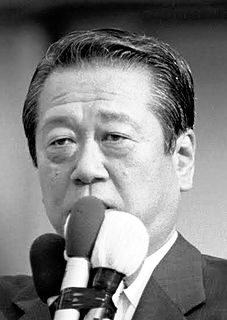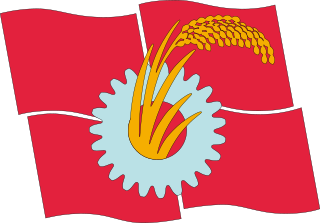
The New Frontier Party was a political party in Japan founded in December 1994. As a merger of several small parties, the party was ideologically diverse, with its membership ranging from moderate social democrats to liberals and conservatives. The party dissolved in December 1997, with Ichirō Ozawa's faction forming the Liberal Party and other splinters later joining the Democratic Party of Japan in April 1998.

The New Party Nippon is a Japanese political party formed on August 21, 2005. The party is headed by the former Nagano governor Yasuo Tanaka, and includes Diet members Kōki Kobayashi, Takashi Aoyama, Makoto Taki, and Hiroyuki Arai, who left the Liberal Democratic Party in opposition to Prime Minister Junichiro Koizumi’s postal privatization drive.
This article presents detail of the results in the Japan general election, 2003, breaking down results by block district. The 11 block districts elected 180 members by proportional representation, and 300 members were elected from single-member districts distributed among the 47 prefectures.
This article presents detail of the results in the Japan general election, 2005, breaking down results by block district. The 11 block districts elected 180 members by proportional representation, and 300 members were elected from single-member districts distributed among the 47 prefectures.

The 21st Elections to the House of Councillors for the upper house of the legislature of Japan were held on July 29, 2007. The date was originally to be July 22, but the ruling Liberal Democratic Party (LDP) decided in mid-June to extend the session of the House for a week to finish up legislative business; this step was criticised due to the short-term delay.

Elections for the Japanese House of Councillors were held in Japan on 29 July 2001. It was the first national election since Junichiro Koizumi was appointed as prime minister after Yoshiro Mori resigned in April 2001. The Liberal Democratic Party (LDP) and its election allies, were the major winner, provided Koizumi a strong mandates to move forward with his reform policies. The ruling coalition performed well, and regain their majority in the House of Councillors.

Elections for the Japanese House of Councillors were held in Japan on July 12, 1998.

The 22nd Elections to the House of Councillors for the upper house of the legislature of Japan were held on July 11, 2010. In the last election in 2007, the Liberal Democratic Party (LDP) lost its majority to the Democratic Party (DPJ), which managed to gain the largest margin since its formation in 1996. The House of Councillors is elected by halves to six-year terms. The seats up for election in 2010 were last contested in the 2004 election.

The Hokkaidō proportional representation block or in official usage the "Hokkaidō electoral district" is one of eleven proportional representation (PR) blocks for the House of Representatives in the Diet of Japan. It consists of Hokkaidō and is one of two PR blocks that covers only one prefecture, the other being Tokyo. Following the introduction of proportional voting, it elected nine representatives in the election of 1996. Since 2000, the Hokkaidō PR block has been represented by eight representatives.
The Shikoku proportional representation block is one of eleven proportional representation (PR) "blocks", multi-member constituencies for the House of Representatives in the Diet of Japan. It consists of Shikoku region covering Tokushima, Kagawa, Ehime and Kōchi Prefectures. Following the introduction of proportional voting it elected seven representatives in the 1996 general election. When the total number of PR seats was reduced from 200 to 180, the Shikoku PR block shrunk to six seats.
The Tōkyō proportional representation block is one of eleven proportional representation (PR) "blocks", multi-member constituencies for the House of Representatives in the Diet of Japan. It consists solely of the prefecture of Tokyo making it one of two blocks covering only one prefecture, the other being Hokkaido. Following the introduction of proportional voting Tokyo elected 19 representatives by PR in the 1996 general election, and 17 since the election of 2000 when the total number of PR seats was reduced from 200 to 180.
The Hatomander was an electoral reform proposed in the 1950s by Japanese prime minister Ichirō Hatoyama and his third cabinet. His plan was to replace the SNTV multi-member constituencies for the House of Representatives entirely with First-past-the-post single-member districts. The change would have made it easier for Hatoyama's Liberal Democratic Party (LDP) to gain a two-thirds majority on its own, enabling him to pursue his plan to change the Japanese Constitution, particularly Article 9. The plan faced strong opposition led by the Japanese Socialist Party (JSP) that accused Hatoyama of wanting to "hatomander" the electoral districts to his needs. An electoral reform bill was presented to the Diet in March 1956, passed the House of Representatives in May 1956, but was not voted on in the House of Councillors in a still ongoing debate at the end of the Diet session. The LDP failed to win a majority in the House of Councillors election in July, and the plan was shelved.
The Southern Kantō proportional representation block is one of eleven proportional representation (PR) "blocks", multi-member constituencies for the House of Representatives in the Diet of Japan. It consists of Southern parts of the Kantō region covering Chiba, Kanagawa and Yamanashi prefectures. Following the introduction of proportional voting it initially elected 23 representatives in the 1996 general election, then 21 after the total number of PR seats had been reduced from 200 to 180, and 22 representatives since the reapportionment of 2002.
Politics of Kanagawa, as in all prefectures of Japan, takes place in the framework of local autonomy that is guaranteed by the Constitution and laid out in the Local Autonomy Law. The administration is headed by a governor directly elected by the people every four years in first-past-the-post elections. Legislation, the budget and the approval of personnel appointments, including the vice governors, are handled by the prefectural assembly that is directly elected by the people every four years by single-non transferable vote.

The 23rd Elections to the House of Councillors for the upper house of the National Diet, the legislature of Japan, was held on July 21, 2013. In the last election in 2010, the Democratic Party of Japan (DPJ) remained the largest party, but the DPJ-led ruling coalition lost its majority. The House of Councillors is elected by halves to six year terms. In 2013, the class of Councillors elected in 2007 was up.

The 24th regular election of members of the House of Councillors was held on Sunday 10 July 2016 to elect 121 of the 242 members of the House of Councillors, the upper house of the 717-member bicameral National Diet of Japan, for a term of six years. As a result of the election, the LDP/Komeito coalition gained ten seats for a total of 146, the largest coalition achieved since the size of the house was set at 242 seats.
The Hyogo at-large district is a constituency that represents Hyogo Prefecture in the House of Councillors in the Diet of Japan. It currently has five Councillors in the 242-member house, but this representation will increase to six by July 2019.
The Tottori-Shimane at-large district is a constituency of the House of Councillors in the Diet of Japan. It was formed pursuant to a 2015 revision of the Public Officers Election Law from a merger of the Tottori and Shimane at-large districts, the two smallest districts in the country, to address the imbalance in representation between rural and urban voters. The district has 1,068,348 registered voters and was contested for the first time at the House of Councillors election that was held on 10 July 2016.

The 25th regular election of members of the House of Councillors will be held on July 2019 to elect 124 of the 245 members of the House of Councillors, the upper house of the then 710-member bicameral National Diet of Japan, for a term of six years.


















